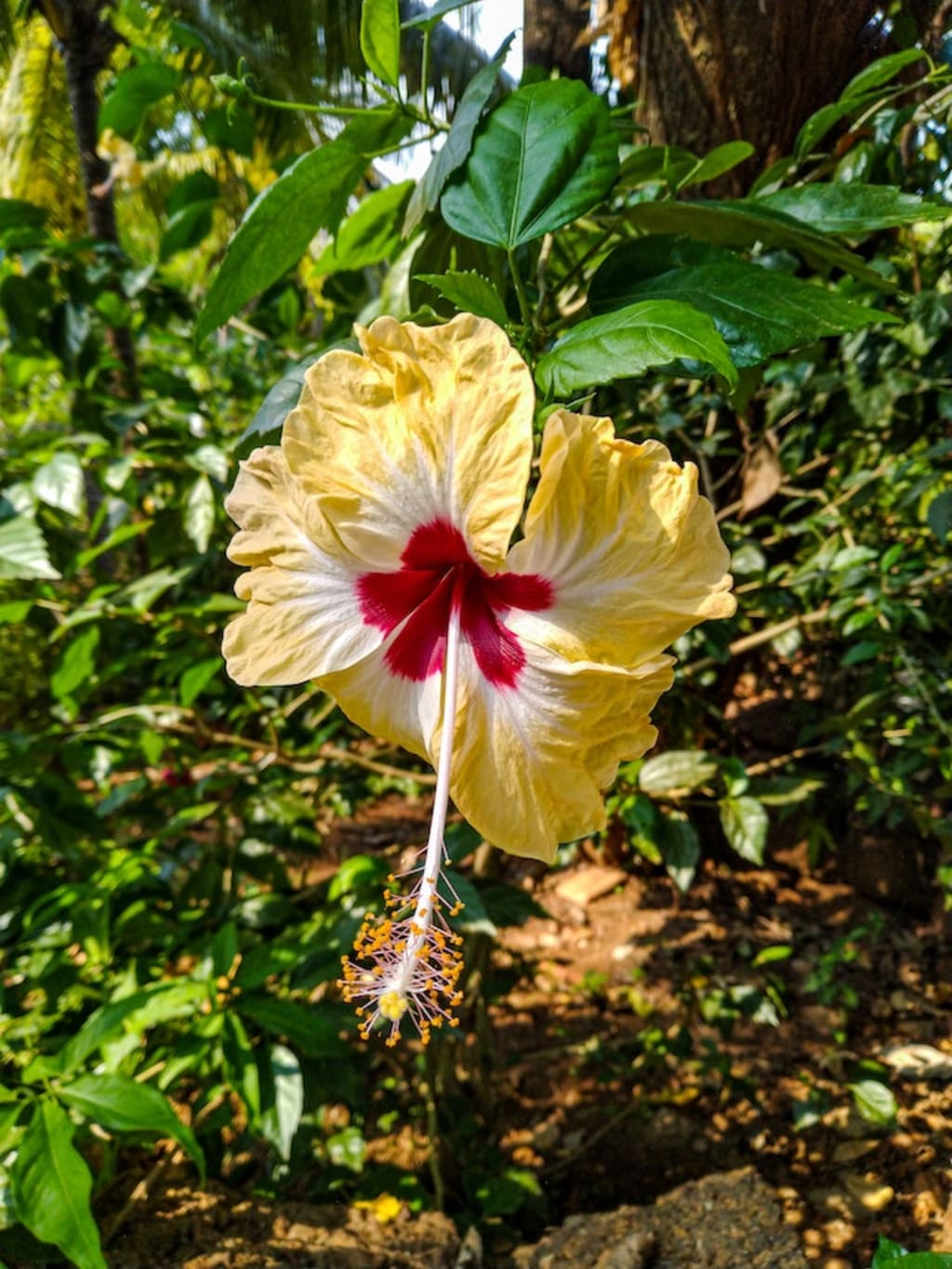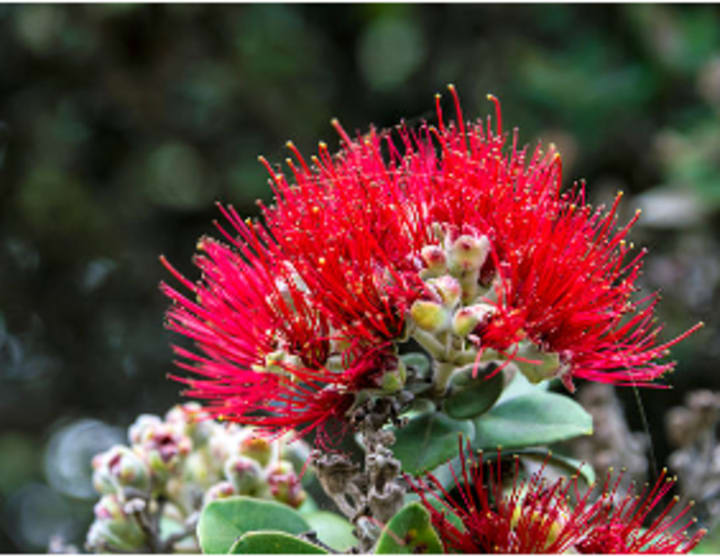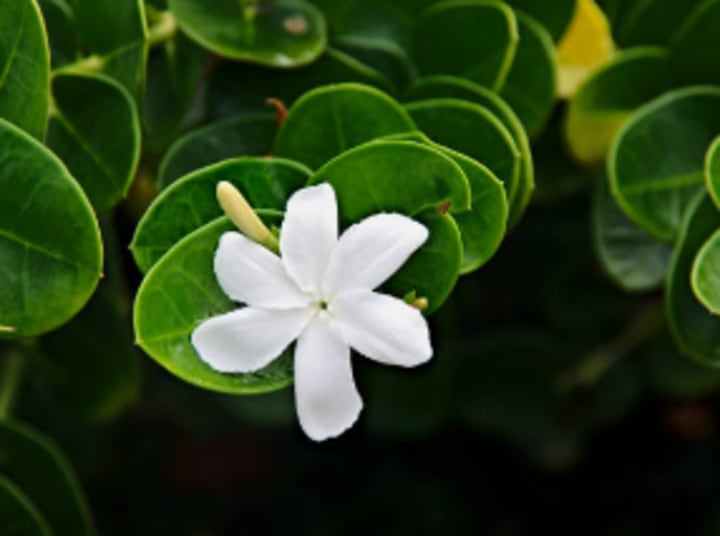
Hawaii is home to exotic and tropical flowers that are an integral part of its culture. You must have seen locals welcoming the visitors with a garland of orchids or plumeria! Discover the best Hawaiian Flowers Names and their growing habits!
1. Hawaiian Hibiscus
The Hawaiian Hibiscus, also known as the Hibiscus brackenridgei, is an iconic flowering plant indigenous to the Hawaiian Islands, renowned for its vibrant and captivating blossoms. These exquisite flowers hold deep cultural significance in Hawaii, where they are often referred to as "Pua Aloalo" or "Hawaii's native hibiscus."
Hawaiian Hibiscus stands out for its spectacularly large and showy flowers, which come in a spectrum of striking colors, including shades of red, yellow, orange, pink, and white. These blossoms can reach up to six inches in diameter, with prominent, funnel-shaped petals and a distinct central stamen crowned by a prominent pistil. The flowers often feature an eye-catching contrast between their colorful petals and a deep crimson or maroon center, adding to their visual appeal.
Beyond their aesthetic allure, Hawaiian Hibiscus flowers hold deep cultural significance in Hawaiian tradition and folklore. They are a symbol of Hawaii's natural beauty and are often used in the creation of traditional leis (garlands) and as floral decorations in various ceremonies and celebrations. These blossoms are also the official state flower of Hawaii, representing the spirit and natural splendor of the islands.
Caring for Hawaiian Hibiscus requires attention to their specific needs. They thrive in warm and tropical climates with abundant sunlight. Well-draining soil and regular watering are essential for their health and vibrancy. Pruning to encourage bushier growth and the removal of dead or diseased branches is also recommended.
In addition to their ornamental value, Hawaiian Hibiscus plants are recognized for their potential medicinal properties. Traditional Hawaiian healers have used various parts of the plant, including the flowers and leaves, to create herbal remedies. These remedies are believed to offer relief from ailments such as coughs, sore throats, and skin irritations.
Despite their cultural and ecological importance, some species of Hawaiian Hibiscus are endangered due to habitat loss and invasive species. Conservation efforts are in place to protect and restore these iconic plants and their native habitats, ensuring that future generations can continue to admire and appreciate the natural beauty they represent.
In conclusion, the Hawaiian Hibiscus is a symbol of Hawaii's natural splendor, cherished for its spectacular and culturally significant flowers. These vibrant blossoms are not only a testament to the islands' rich biodiversity but also a reminder of the need to protect and preserve these iconic plants for future generations to enjoy.
2. Ohia Lehua
Ohia Lehua, scientifically known as Metrosideros polymorpha, is a remarkable and revered tree native to the Hawaiian Islands, celebrated for its unique beauty, cultural significance, and ecological importance. This iconic plant holds a special place in Hawaiian culture and plays a crucial role in the islands' ecosystems.
Ohia Lehua is renowned for its striking evergreen foliage and vibrant, showy blossoms. The tree's lush green leaves provide essential shade and habitat for various native species, contributing to the rich biodiversity of Hawaii's forests. However, it is the bright and fiery red or yellow flowers that truly capture the imagination. These blossoms, resembling lehua (Ohia) or Lehua (Metrosideros) flowers, are often considered emblematic of the Hawaiian landscape.
Culturally, Ohia Lehua is deeply intertwined with Hawaiian mythology and traditions. According to Hawaiian legend, the tree is associated with the fire goddess Pele. The story tells of a mortal warrior named Ohia who caught the eye of Pele's younger sister, Lehua. When Ohia refused Lehua's advances, Pele turned him into a tree. Lehua, heartbroken by her lover's transformation, was transformed into a flower that now adorns the Ohia tree. It is said that plucking these flowers causes rain, symbolizing the separation of lovers.
The ecological importance of Ohia Lehua extends to its role in maintaining Hawaii's fragile ecosystems. The tree's deep, extensive roots help prevent soil erosion on volcanic slopes and stabilize the terrain. Additionally, it provides essential habitat and sustenance for native bird species, such as the Hawaiian honeycreepers, which are crucial for pollinating native plants.
Sadly, Ohia Lehua faces threats, including the spread of Rapid Ohia Death (ROD), a disease caused by introduced fungal pathogens. ROD has led to significant mortality among Ohia trees, impacting Hawaii's forests and ecosystems.
Efforts are underway to combat ROD and protect Ohia Lehua. These include quarantine measures to prevent the spread of the disease, research on resistant trees, and public awareness campaigns.
In conclusion, Ohia Lehua is an iconic and cherished tree in Hawaiian culture and ecology. Its vibrant blossoms and rich mythology have made it a symbol of Hawaii's natural beauty and cultural heritage. Conservation efforts are crucial to preserve this revered tree and the ecosystems it supports, ensuring that future generations can continue to appreciate its beauty and significance.

3. Pikake
Pikake, scientifically known as Jasminum sambac, is a fragrant and enchanting flowering plant that holds a special place in Hawaiian culture and beyond. This aromatic gem, also known as the Arabian Jasmine, is celebrated for its exquisite blossoms and captivating fragrance.
Pikake is characterized by its small, waxy, white flowers that resemble delicate, star-shaped pinwheels. These flowers often emit a sweet and intoxicating scent, making them a sought-after addition to gardens and landscapes. The name "Pikake" is derived from the Hawaiian word for "peacock," due to the flower's resemblance to a peacock's feathered plume.
The fragrance of Pikake is not only pleasant but also deeply significant in Hawaiian tradition. It is commonly used to create traditional Hawaiian leis (garlands) and floral arrangements, adding an enchanting and aromatic touch to special occasions, ceremonies, and celebrations. Pikake leis are often given as tokens of affection and goodwill, symbolizing love and friendship.
Cultivating Pikake requires attention to its specific needs. These plants thrive in tropical and subtropical climates with well-drained soil and plenty of sunlight. Regular pruning helps maintain their shape and encourages prolific blooming. Pikake is also known to be relatively low-maintenance, making it a popular choice for gardens and landscapes in warm regions.
Beyond its ornamental and aromatic qualities, Pikake has also found its way into various traditional medicines and cosmetics. The essential oil extracted from its flowers is used in perfumes, aromatherapy, and skincare products due to its calming and soothing properties.
In addition to its cultural and aesthetic significance, Pikake plays a vital role in pollination, providing nectar for bees and other pollinators. This makes it an ecologically important plant, contributing to the health of local ecosystems.
While Pikake is primarily associated with Hawaii, its popularity and cultural significance extend beyond the islands. The enchanting fragrance and exquisite beauty of Pikake have made it a cherished and iconic flower in many other parts of the world as well.
In conclusion, Pikake, or Arabian Jasmine, is a fragrant and captivating flowering plant celebrated for its delicate star-shaped flowers and enchanting aroma. It holds deep cultural significance in Hawaiian tradition, where it symbolizes love and friendship through the creation of fragrant leis. Beyond its ornamental value, Pikake also serves as an essential component of ecosystems and finds applications in various products, from perfumes to traditional medicines, ensuring its enduring allure in diverse cultures and landscapes.

About the Creator
Enjoyed the story? Support the Creator.
Subscribe for free to receive all their stories in your feed. You could also pledge your support or give them a one-off tip, letting them know you appreciate their work.





Comments
There are no comments for this story
Be the first to respond and start the conversation.